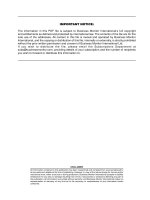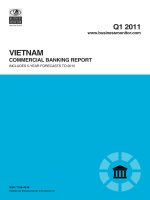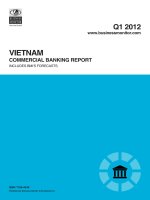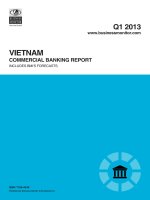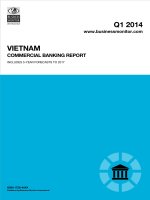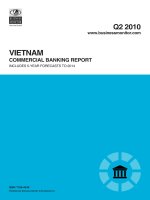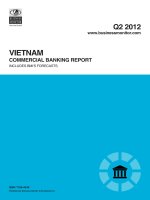Vietnam commercial banking report q3 2012
Bạn đang xem bản rút gọn của tài liệu. Xem và tải ngay bản đầy đủ của tài liệu tại đây (514.54 KB, 70 trang )
Q3 2012
www.businessmonitor.com
COMMERCIAL BANKING REPORT
ISSN 1758-454X
Published by Business Monitor International Ltd.
VIETNAM
INCLUDES BMI'S FORECASTS
Business Monitor International
85 Queen Victoria Street
London
EC4V 4AB
UK
Tel: +44 (0) 20 7248 0468
Fax: +44 (0) 20 7248 0467
Email:
Web: www.businessmonitor.com
© 2012 Business Monitor International.
All rights reserved.
All information contained in this publication is
copyrighted in the name of Business Monitor
International, and as such no part of this publication
may be reproduced, repackaged, redistributed, resold in
whole or in any part, or used in any form or by any
means graphic, electronic or mechanical, including
photocopying, recording, taping, or by information
storage or retrieval, or by any other means, without the
express written consent of the publisher.
DISCLAIMER
All information contained in this publication has been researched and compiled from sources believed to be accurate and reliable at the time of
publishing. However, in view of the natural scope for human and/or mechanical error, either at source or during production, Business Monitor
International accepts no liability whatsoever for any loss or damage resulting from errors, inaccuracies or omissions affecting any part of the
publication. All information is provided without warranty, and Business Monitor International makes no representation of warranty of any kind as
to the accuracy or completeness of any information hereto contained.
VIETNAM COMMERCIAL
BANKING REPORT Q3 2012
INCLUDES 5-YEAR FORECASTS TO 2016
Part of BMI’s Report & Forecasts Series
Published by: Business Monitor International
Copy deadline: July 2012
Vietnam Commercial Banking Report Q3 2012
© Business Monitor International Ltd Page 2
Vietnam Commercial Banking Report Q3 2012
© Business Monitor International Ltd Page 3
CONTENTS
Executive Summary 5
Table: Levels (VNDbn) 5
Table: Levels (US$bn) 5
Table: Levels At October 2011 5
Table: Annual Growth Rate Projections 2012-2016 (%) 5
Table: Ranking Out Of 59 Countries Reviewed In 2011 6
Table: Projected Levels (VNDbn) 6
Table: Projected Levels (US$bn) 6
SWOT Analysis 7
Vietnam Commercial Banking SWOT 7
Vietnam Political SWOT 8
Vietnam Economic SWOT 9
Vietnam Business Environment SWOT 10
Business Environment Outlook 11
Commercial Banking Business Environment Rating 11
Table: Commercial Banking Business Environment Ratings 11
Commercial Banking Business Environment Rating Methodology 12
Table: Asia Commercial Banking Business Environment Ratings 13
Global Commercial Banking Outlook 14
Asia Outlooks 22
Trade Finance Growth Set To Slow 22
Asia Banking Sector Forecast Overview 26
Table: Banks' Bond Portfolios 2011 26
Table: Asia Commercial Banking Business Environment Ratings 27
Table: Comparison of Loan/Deposit & Loan/Asset & Loan/GDP ratios 28
Table: Anticipated Developments in 2012 29
Table: Comparison of Total Assets & Client Loans & Client Deposits (US$bn) 30
Table: Comparison of US$ Per Capita Deposits (2011) 31
Table: Interbank Rates and Bond Yields 32
Vietnam Specific Banking Sector Outlook 33
Assessing The Risks Behind Vietinbank's Debt Issue 33
Economic Outlook 37
Table: Vietnam – Economic Activity, 2011-2016 39
Competitive Landscape 40
Market Structure 40
Protagonists 40
Table: Protagonists In Vietnam's Commercial Banking Sector 40
Definition Of The Commercial Banking Universe 40
List Of Banks 41
Table: Financial Institutions In Vietnam 41
Vietnam Commercial Banking Report Q3 2012
© Business Monitor International Ltd Page 4
Company Profiles 44
Bank for Foreign Trade of Vietnam (Vietcombank) 44
Table: Vietnam Stock Market Indicators 45
Table: Vietnam Balance Sheet (US$mn) 45
Table: Vietnam Key Ratios (%) 45
VietinBank 46
Table: Key Statistics For VietinBank, 2005-2008 (VNDmn) 47
Agribank 48
Table: Vietnam Balance Sheet (LCYmn) 49
Table: Vietnam Balance Sheet (US$mn) 49
Table: Vietnam Key Ratios (%) 49
Asia Commercial Bank 50
Table: Vietnam Stock Market Indicators 51
Table: Vietnam Balance Sheet (LCYmn) 51
Table: Vietnam Balance Sheet (US$mn) 51
Table: Vietnam Key Ratios (%) 52
Eximbank 53
Table: Balance Sheet (VNDmn, unless stated) 54
Table: Balance Sheet (US$mn, unless stated) 54
Table: Key Ratios (%) 54
Vietnam Technological and Commercial Joint-stock Bank (Techcombank) 55
Table: Vietnam Balance Sheet (LCYmn) 56
Table: Vietnam Balance Sheet (US$mn) 56
Table: Vietnam Key Ratios (%) 56
Viet A Joint Stock Commercial Bank (Vietabank) 57
Table: Vietnam Stock Market Indicators 57
Table: Vietnam Balance Sheet (LCYmn) 58
Table: Vietnam Balance Sheet (US$mn) 58
Table: Vietnam Key Ratios (%) 59
Housing Development Commercial Joint Stock Bank (HDBank) 60
Sacombank 61
Table: Stock Market Indicators 62
Table: Balance Sheet (VNDmn, unless stated) 62
Table: Balance Sheet (US$mn, unless stated) 63
Table: Key Ratios (%) 63
BMI Banking Sector Methodology 64
Commercial Bank Business Environment Rating 66
Table: Commercial Banking Business Environment Indicators And Rationale 67
Table: Weighting Of Indicators 68
Vietnam Commercial Banking Report Q3 2012
© Business Monitor International Ltd Page 5
Executive Summary
Table: Levels (VNDbn)
Date
Total assets
Client
loans
Bond
portfolio
Other
Liabilities
and capital
Capital
Client
deposits
Other
October 2010 2,771,909.8
2,314,760.0
210,505.1
246,644.7
2,771,909.8
384,514.0
2,106,934.6
280,461.2
October 2011 3,264,325.0
2,717,010.0
256,893.0
290,422.0
3,264,325.0
533,828.0
2,412,745.0
317,752.0
Change, % 18%
17%
22%
18%
18%
39%
15%
13%
Source: BMI; Central banks; Regulators
Table: Levels (US$bn)
Date
Total
assets
Client
loans
Bond
portfolio
Other
Liabilities
and capital
Capital
Client
deposits
Other
October 2010 142.2
118.7
10.8
12.6
142.2
19.7
108.1
14.4
October 2011 155.4
129.4
12.2301
13.8
155.4
25.4
114.9
15.1
Change, % 9%
9%
13%
9%
9%
29%
6%
5%
Source: BMI; Central banks; Regulators
Table: Levels At October 2011
Loan/deposit ratio
Loan/asset ratio
Loan/GDP ratio
GDP Per Capita, US$
Deposits per capita, US$
112.61% 83.23%
113.06%
1,072
1,296
Rising Falling
Falling
Source: BMI; Central banks; Regulators
Table: Annual Growth Rate Projections 2012-2016 (%)
Assets
Loans
Deposits
Annual Growth Rate 16
16
11
CAGR 20
19
13
Ranking 3
3
15
Source: BMI; Central banks; Regulators
Vietnam Commercial Banking Report Q3 2012
© Business Monitor International Ltd Page 6
Table: Ranking Out Of 59 Countries Reviewed In 2011
Loan/deposit ratio Loan/asset ratio
Loan/GDP ratio
10 1
13
Local currency asset
growth Local currency loan growth
Local currency deposit growth
3 3
8
Source: BMI; Central banks; Regulators
Table: Projected Levels (VNDbn)
2009
2010
2011e
2012f
2013f
2014f
2015f
2016f
Total assets 2,286,320.58
2,953,153.46
3,632,378.76
4,467,825.87
5,406,069.30
6,487,283.16
7,654,994.13
8,879,793.19
Client loans 1,869,260.00
2,475,540.00
3,020,158.80
3,684,593.74
4,458,358.42
5,350,030.10
6,313,035.52
7,323,121.21
Client deposits 1,680,716.80
2,209,896.20
2,651,875.44
3,076,175.51
3,506,840.08
3,962,729.29
4,438,256.81
4,926,465.06
e/f = estimate/forecast. Source: BMI; Central banks; Regulators
Table: Projected Levels (US$bn)
2008
2009
2010
2011e
2012f
2013f
2014f
2015f
2016f
Total assets 99.94
123.73
151.46
172.68
212.40
259.91
315.45
376.54
441.78
Client loans 76.60
101.16
126.96
143.58
175.16
214.34
260.15
310.53
364.33
Client deposits 76.71
90.95
113.34
126.07
146.24
168.60
192.69
218.31
245.10
e/f = estimate/forecast. Source: BMI; Central banks; Regulators
Vietnam Commercial Banking Report Q3 2012
© Business Monitor International Ltd Page 7
SWOT Analysis
Vietnam Commercial Banking SWOT
Strengths
Rapid growth.
Untapped potential.
High savings rate of Vietnamese.
Weaknesses
Domestic banks lack capital and technology to sustain high credit growth.
The financial accounts of many banks are still opaque.
Opportunities
The population is still underbanked.
Income levels likely to rise strongly over the medium term.
Threats
Macroeconomic instability threatens the credibility of the government and could
potentially move economic policy away from further liberalisation.
Vietnam Commercial Banking Report Q3 2012
© Business Monitor International Ltd Page 8
Vietnam Political SWOT
Strengths
The Communist Party of Vietnam remains committed to market-oriented reforms and
we do not expect major shifts in policy direction over the next five years. The one-party
system is generally conducive to short-term political stability.
Relations with the US have witnessed a marked improvement, and Washington sees
Hanoi as a potential geopolitical ally in South East Asia.
Weaknesses
Corruption among government officials poses a major threat to the legitimacy of the
ruling Communist Party.
There is increasing (albeit still limited) public dissatisfaction with the leadership's tight
control over political dissent.
Opportunities
The government recognises the threat corruption poses to its legitimacy, and has
acted to clamp down on graft among party officials.
Vietnam has allowed legislators to become more vocal in criticising government
policies. This is opening up opportunities for more checks and balances within the one-
party system.
Threats
Macroeconomic instabilities in 2012 are likely to weigh on public acceptance of the
one-party system, and street demonstrations to protest economic conditions could
develop into a full-on challenge of undemocratic rule.
Although strong domestic control will ensure little change to Vietnam's political scene
in the next few years, over the longer term, the one-party-state will probably be
unsustainable.
Relations with China have deteriorated over recent years due to Beijing's more
assertive stance over disputed islands in the South China Sea and domestic criticism
of a large Chinese investment into a bauxite mining project in the central highlands,
which could potentially cause wide-scale environmental damage.
Vietnam Commercial Banking Report Q3 2012
© Business Monitor International Ltd Page 9
Vietnam Economic SWOT
Strengths
Vietnam has been one of the fastest-growing economies in Asia in recent years, with
GDP growth averaging 7.1% annually between 2000 and 2011.
The economic boom has lifted many Vietnamese out of poverty, with the official
poverty rate in the country falling from 58% in 1993 to 14.0% in 2010.
Weaknesses
Vietnam still suffers from substantial trade, current account and fiscal deficits, leaving
the economy vulnerable to global economic uncertainties in 2012. The fiscal deficit is
dominated by substantial spending on social subsidies that could be difficult to
withdraw.
The heavily-managed and weak currency reduces incentives to improve quality of
exports, and also keeps import costs high, contributing to inflationary pressures.
Opportunities
WTO membership has given Vietnam access to both foreign markets and capital,
while making Vietnamese enterprises stronger through increased competition.
The government will in spite of the current macroeconomic woes, continue to move
forward with market reforms, including privatisation of state-owned enterprises, and
liberalising the banking sector.
Urbanisation will continue to be a long-term growth driver. The UN forecasts the urban
population rising from 29% of the population to more than 50% by the early 2040s.
Threats
Inflation and deficit concerns have caused some investors to re-assess their hitherto
upbeat view of Vietnam. If the government focuses too much on stimulating growth
and fails to root out inflationary pressure, it risks prolonging macroeconomic instability,
which could lead to a potential crisis.
Prolonged macroeconomic instability could prompt the authorities to put reforms on
hold as they struggle to stabilise the economy.
Vietnam Commercial Banking Report Q3 2012
© Business Monitor International Ltd Page 10
Vietnam Business Environment SWOT
Strengths
Vietnam has a large, skilled and low-cost workforce, that has made the country
attractive to foreign investors.
Vietnam's location – its proximity to China and South East Asia, and its good sea links
– makes it a good base for foreign companies to export to the rest of Asia, and
beyond.
Weaknesses
Vietnam's infrastructure is still weak. Roads, railways and ports are inadequate to cope
with the country's economic growth and links with the outside world.
Vietnam remains one of the world's most corrupt countries. According to Transparency
International's 2011 Corruption Perceptions Index, Vietnam ranks 112 out of 183
countries.
Opportunitie
s
Vietnam is increasingly attracting investment from key Asian economies, such as
Japan, South Korea and Taiwan. This offers the possibility of the transfer of high-tech
skills and know-how.
Vietnam is pressing ahead with the privatisation of state-owned enterprises and the
liberalisation of the banking sector. This should offer foreign investors new entry
points.
Threats
Ongoing trade disputes with the US, and the general threat of American protectionism,
which will remain a concern.
Labour unrest remains a lingering threat. A failure by the authorities to boost skills
levels could leave Vietnam a second-rate economy for an indefinite period.
Vietnam Commercial Banking Report Q3 2012
© Business Monitor International Ltd Page 11
Business Environment Outlook
Commercial Banking Business Environment Rating
Table: Commercial Banking Business Environment Ratings
Limits of potential returns
Data
Score; out of 10
Ratings score; out of 100
Total assets; end 2012, US$bn 172.7
6
Market Structure 70
Growth in total assets; 2012-2016, US$bn 229.4
7
Growth in client loans; 2012-2016, US$bn 189.2
8
Per-capita GDP; 2012, US$ 1,509.0
3
Country Structure 55
Tax 2.9
3
GDP volatility 0.9
10
Financial infrastructure 5.6
6
Risks to realisation of returns
Regulatory framework and development 2.0
2
Market Risk 37
Regulatory framework and competitive landscape 5.0
5
Moody's rating for local currency deposits 3.5
4
Long-term financial risk 4.6
5
Country Risk 46
Long-term external risk 3.3
3
Long-term policy continuity 7.0
7
Legal framework 3.7
4
Bureaucracy 3.9
4
Commercial banking business environment rating
57
Source: BMI, National Sources
Vietnam Commercial Banking Report Q3 2012
© Business Monitor International Ltd Page 12
Commercial Banking Business Environment Rating Methodology
Since Q108, we have described numerically the banking business environment for each of the countries
surveyed by BMI. We do this through our Commercial Banking Business Environment Rating (CBBER),
a measure that ensures we capture the latest quantitative information available. It also ensures consistency
across all countries and between the inputs to the CBBER and the Insurance Business Environment
Rating, which is likewise now a feature of our insurance reports. Like the Business Environment Ratings
calculated by BMI for all the other industries on which it reports, the CBBER takes into account the limits
of potential returns and the risks to the realisation of those returns. It is weighted 70% to the former and
30% to the latter.
The evaluation of the 'Limits of potential returns' includes market elements that are specific to the
banking industry of the country in question and elements that relate to that country in general. Within the
70% of the CBBER that takes into account the 'Limits of potential returns', the market elements have a
60% weighting and the country elements have a 40% weighting. The evaluation of the 'Risks to
realisation of returns' also includes banking elements and country elements (specifically, BMI's
assessment of long-term country risk). However, within the 30% of the CBBER that take into account the
risks, these elements are weighted 40% and 60%, respectively.
Further details on how we calculate the CBBER are provided at the end of this report. In general, though,
three aspects need to be borne in mind in interpreting the CBBERs. The first is that the market elements
of the 'Limits of potential returns' are by far the most heavily weighted of the four elements. They account
for 60% of 70% (or 42%) of the overall CBBER. Second, if the market elements are significantly higher
than the country elements of the 'Limits of potential returns', it usually implies that the banking sector is
(very) large and/or developed relative to the general wealth, stability and financial infrastructure in the
country. Conversely, if the market elements are significantly lower than the country elements, it usually
means that the banking sector is small and/or underdeveloped relative to the general wealth, stability and
financial infrastructure in the country. Third, within the 'Risks to the realisation of returns' category, the
market elements (i.e. how regulations affect the development of the sector, how regulations affect
competition within it, and Moody's Investor Services' ratings for local currency deposits) can be markedly
different from BMI's long-term risk rating.
Vietnam Commercial Banking Report Q3 2012
© Business Monitor International Ltd Page 13
Table: Asia Commercial Banking Business Environment Ratings
Limits of Potential
Returns
Risks to Potential
Returns Overall
Market
Structure
Country
Structure
Market
Risks
Country
Risks
Rating
Ranking
Bangladesh 50.0
45.0
43.3
44.0
46.7
52
China 93.3
55.0
63.3
74.0
75.5
13
Hong Kong 76.7
92.5
73.3
84.0
82.0
6
India 83.3
57.5
60.0
56.0
68.4
28
Indonesia 76.7
65.0
80.0
52.0
69.4
26
Japan 33.3
77.5
66.7
80.0
58.1
37
Malaysia 73.3
80.0
83.3
80.0
77.6
10
Pakistan 40.0
50.0
53.3
42.0
44.8
55
Philippines 50.0
62.5
60.0
58.0
56.1
44
Singapore 53.3
95.0
96.7
90.0
76.8
11
Sri Lanka 20.0
55.0
33.3
46.0
36.1
58
South Korea 80.0
82.5
83.3
76.0
80.4
8
Taiwan 76.7
72.5
86.7
76.0
76.6
12
Thailand 63.3
65.0
86.7
74.0
68.5
27
Vietnam 70.0
55.0
36.7
46.0
57.5
40
United States 90.0
85.0
100.0
80.0
88.0
2
Scores out of 100, with 100 the highest. Source: BMI
Vietnam Commercial Banking Report Q3 2012
© Business Monitor International Ltd Page 14
Global Commercial Banking Outlook
Global Credit Divergence
Despite major risks emanating from the European debt crisis (which we looked at closely in the Q1 2012
report in the article 'Europe On The Brink'), our overall global banking outlook remains relatively benign.
Of 62 banking sectors forecast by BMI, we are forecasting lending expansion in 52 in 2012, with the nine
non-growing or contracting sectors dominated by developed states/eurozone members (Australia, Austria,
Spain, Greece, Italy, Japan, and Slovenia), with Latvia (an EU member borderline developed state by
global banking standards) and Iran the only EM representatives. This is a microcosm of our global view
as a whole, which is that banking sectors in most developed states will continue to struggle amid
government austerity and household deleveraging, whereas by and large, emerging market banking
sectors will continue to expand.
Using comparable data from the IMF (which we use for our global credit aggregate series) going up to the
end of 2011, two trends stand out. Firstly, emerging market banking sectors are catching up rapidly to the
world's two biggest banking sectors, the US and the eurozone, in terms of lending growth. Since the
global financial crisis began in 2007, it is clear that the US and eurozone combined have lagged the rest
of the world in credit creation. In fact, while several emerging market economies continue to set new
domestic records for credit outstanding, the US plus the eurozone have gone basically nowhere for three
years, as the accompanying chart shows. In fact, credit in the US plus eurozone has fallen from an
estimated 54% of all global credit to around 46%, a downward trend which we see continuing in the years
ahead.
Vietnam Commercial Banking Report Q3 2012
© Business Monitor International Ltd Page 15
US And Eurozone Back In The Minority For Global Credit
Global Credit Aggregates (US$bn)
Source: IMF, BMI
Secondly, between the US and eurozone, we are more optimistic that the US is past the worst. There are
significant risks that despite ECB intervention, credit growth in the eurozone is likely to continue to
deteriorate. Of course, there is a great deal of differentiation between credit aggregates in different euro
area members, with troubled countries such as Ireland, Greece and Spain experiencing major credit
contractions, while France and Germany among others are still posting fairly strong numbers. But on the
whole, eurozone credit growth is negative and heading lower. Here is a chart of year-on-year consumer
credit growth in the US and eurozone. While this should be taken with the caveat that US consumer
lending includes government-subsidised student loans, the US appears to have turned the corner in overall
consumer credit, whereas we expect further stagnation in the eurozone.
Vietnam Commercial Banking Report Q3 2012
© Business Monitor International Ltd Page 16
US Consumer Lending Turning The Corner?
US v Eurozone Consumer Credit (% chg y-o-y)
Source: Eurostat, Federal Reserve, BMI
While US mortgage lending continues to be a sore point in the US economy as deleveraging continues, it
appears that the contraction has steadied at around -2% y-o-y. This should head higher in a few years'
time. In contrast, eurozone mortgage lending has been healthy by comparison, but is beginning to slow
rapidly (down from 5.0% y-o-y in early 2011 to 2.0% in Q411).
Vietnam Commercial Banking Report Q3 2012
© Business Monitor International Ltd Page 17
Both Could Be Negative Soon
US v Eurozone Mortgage Credit Outstanding (% chg y-o-y)
Source: Eurostat, Federal Reserve, BMI
Finally, looking at corporate debt growth as well, the US has the advantage. Interestingly, the data
indicate that European corporates are looking increasingly to debt instrument issuance as opposed to bank
lending for financing, which plays up the contrast between healthy corporate balance sheets and weak
banks.
Vietnam Commercial Banking Report Q3 2012
© Business Monitor International Ltd Page 18
US Corporates Have The Edge
US v Eurozone Corporate Credit (% chg y-o-y)
Source: Eurostat, Federal Reserve, BMI
Our overarching view is that further weakness is ahead for European banks, while US financial
institutions are in better shape going forward. Overall global credit growth will continue to be driven by
non-eurozone and US institutions, however, led by emerging markets. That view comes with the caveat
that within EM, selectivity is key, and a further downturn in either the US or European banking systems
would reverberate globally.
Emerging Markets Regional Overviews
Emerging Asia: In 2012 we expect weaker earnings, hampered by foreign funding constraints, slower
credit growth, and higher non-performing loans. One corollary of the surge in credit growth seen in 2010
and 2011, and the inevitable slowdown in 2012, will be a resurgence in non-performing loans (NPLs).
Our core view is for a sharp slowdown in real GDP growth across the board this year, lead by a hard
landing in China and a slowdown in trade growth driven by a recession in the eurozone. These factors
alone are likely to lead to an uptick in NPLs. However, when we combine this with the impact of
weakening housing markets across the region and tighter availability of credit, the impact on NPLs is
likely to be exacerbated. We look for the likes of China, Hong Kong, and Australia to see a surge in bad
debts in 2012.
Emerging Europe: We maintain our wary view towards Central and Eastern European (CEE) banking
sectors on the back of continued macroeconomic and financial headwinds emanating from the eurozone
sovereign debt crisis. We also hold to our preference for the Czech Republic and Poland's banking sectors
Vietnam Commercial Banking Report Q3 2012
© Business Monitor International Ltd Page 19
on the grounds of stability and growth potential, respectively, while reaffirming our negative outlook for
the Hungarian and Ukrainian banking. We also caution that Southeastern European banking sectors are
showing some worrying risk indicators.
Things Could Get Much Worse
Hungary – Non-Performing Loan Data
Source: BMI, Magyar Nemzeti Bank
Latin America: We believe asset and loan growth will remain strong in 2012, driven by stable
fundamentals and the use of monetary stimulus in those markets where credit cycles are slowing. In
addition, we do not view the prevalence of European banks operating in the Latin American region as a
risk to regional banking sector stability. Indeed, those sectors which have greater foreign participation
tend to be the most attractive from a growth perspective, with any serious threats to sector stability
coming mainly from domestic factors.
Vietnam Commercial Banking Report Q3 2012
© Business Monitor International Ltd Page 20
Some Sectors Have Plenty Of Room To Catch Up
Latin America – Client Loans Per Capita, US$
Source: BMI, SBIF, BCB, SFC, CNBV
Sub-Saharan Africa: The outlook for the South African, Nigerian, Kenyan and Ghanaian banking
sectors is mixed. We see Nigeria and Ghana as having the strongest growth potential over the coming
year, while South Africa should see slow but stable expansion, and Kenya will likely struggle amid
various macroeconomic challenges.
Vietnam Commercial Banking Report Q3 2012
© Business Monitor International Ltd Page 21
Multi
-
Year Deleveraging For Some
MENA – Loan-to-GDP, %
Source: BMI, central banks
Middle East And North Africa: Financial institutions in Qatar and Oman are likely to outperform over
the coming quarters, with growth in the latter supported in large part through the long awaited
introduction of Islamic banking to the country. In contrast, risks to underlying stability remain
pronounced in Iran and Egypt, with banks in the former effectively frozen out of the international
financial system as a result of Western sanctions.
Vietnam Commercial Banking Report Q3 2012
© Business Monitor International Ltd Page 22
Asia Outlooks
Trade Finance Growth Set To Slow
BMI View: FX denominated loans have flourished across Asia over the past year as regional banks have
taken up the slack amid eurozone retrenchment and still-strong corporate demand. While this has been a
major boost to profits throughout the industry, the failure of FX deposits to keep up with loans has left a
worryingly large loan-to-deposit overhang. As such, funding costs are likely to rise, which will weigh on
margins, and there are growing risks in the event of a deterioration in US financial conditions. That said,
regional central banks are as flush as ever with US dollars, and swap lines are in place, meaning that a
collapse in trade financing is unlikely.
In our Q112 Asia Banking Sector report, we highlighted three risks to the outlook for Asian banks.
Foreign funding constraints, slowing credit growth, and rising non-performing loans (NPLs) continue to
cloud the outlook for Asian banking sector profits in 2012, and the performance of equities. So far, we
have started to see signs of a slowdown in credit growth on the whole. However, one area that continues
to show robust growth is trade financing. With European banks retrenching en masse amid sovereign
concerns within the eurozone, Asian banks have stepped in to fill the void left in the trade finance market
as corporates have looked to take advantage of low US dollar interest rates versus local currency rates. As
a result, FX loans have proliferated over the past year, resulting in strong profit growth, but also a
growing asset-liability mismatch.
Vietnam Commercial Banking Report Q3 2012
© Business Monitor International Ltd Page 23
Boom
ing Growth Figures
Asia – FX Loan Growth Across Asia In 2011
Source: BMI, Regional Central Banks
Asia Eating Into Europe's Dominance
The trade finance market, estimated to be worth as much as US$10trn a year globally, and supporting in
excess of 80% of global trade, has traditionally been dominated by European banks, which up until
recently held a dominant market share. With European banks deleveraging and trying to improve their
capital adequacy ratios amid sovereign default concerns, Asian banks have been keen to pick up the slack,
given the relatively low risk nature of the industry and the strong growth in intra-Asian trade seen over
recent years.
According to Dealogic, three of the region's top five providers of trade finance by market share in Q112
were Asian. This compares with only one of the top five a year ago. Not only has strong trade growth
over recent years driven a trade finance boom, but they have been positively reinforcing each other. One
of the reasons global trade flows have held up relatively well despite the ongoing eurozone crisis is the
robustness of trade financing in Asia. In the 2008-09 global financial crisis, banking sector instability
caused a major pullback from the industry, generating a vicious cycle of deteriorating economic
conditions and banking sector stress. The willingness of Asian banks to step in to fill the void has been a
major supportive factor for regional trade and economic growth. While exports to the euozone have
softened in recent months, there has been no material deterioration in intra-Asian trade.
Dealogic data shows that Japanese banks have made a particularly strong leap into the sector, with
Mitsubishi UFJ Financial Group now ranking first in the region by market share with 16.6% of the
Vietnam Commercial Banking Report Q3 2012
© Business Monitor International Ltd Page 24
market in the first quarter, up from just 5.5% last year, while Sumitomo Mitsui Financial Group has
more than doubled its market share to 9.6%. Singaporean banks are also expanding rapidly in this area,
with DBS reporting that trade finance accounted for half of its loan growth last year.
Worryingly High Loan-to-Deposit Mismatch
As we mentioned in our previous banking sector report, however, this lending boom has meant that Asian
banks are now sitting on very high FX loans to deposit ratios. For the region as a whole we estimate the
total FX loans-to-deposit ratio is in excess of 100% as a result of double-digit FX loan growth in 2011.
This makes short-term funding, mainly in US dollars, crucial to keeping these loan levels elevated, and
here the risks are noteworthy. These concerns were recently highlighted by Moody's, which cautioned
about the growing asset-liability mismatch. In our view, we could see funding costs rise for Asian banks
given the growing dollar demand, particularly if we begin to see signs of credit stress develop in the US
banking sector. Indeed, with Asian banks using swap agreements with their US counterparts to fund
lending, a rise in swap spreads represents a major risk. This is likely to weigh on margins and also lead to
a slowdown in FX lending over the coming months. Furthermore, while we are bullish towards Asian FX
in the near term, we continue to see weakness across the region in H212, which would raise the local
currency value of borrowings, making it more difficult to meet loan repayments.
Large FX Loan Overhang
Asia – Loan-to-Deposit Ratios And FX Loan Growth
Source: BMI
On the whole, Asian external balance sheets are in good health, with most countries in the region holding
more international reserves then prior to the global financial crisis. As such, US dollars would be readily
available from central banks in the event that dollar funding dries up. The potential for a re-opening of the

